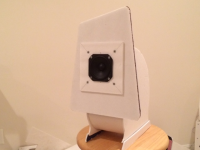I have a couple on the way now and will test and report back when I get them. I think the phase plug may indeed be the cause of some of the anomalies. For a driver this small a dust cap acting as a dome tweeter may be a better choice.
Last edited:
7dB variation at 10khz from 0 to 30deg is pretty good. 17dB at 45 deg is just about average for this size driver - but putting it in a Karlsonator or XKi will level it quite a bit more from 0-45deg.
is a dual-8 Karlsonator/XKi feasible ? or do the dimensions get too funky? for a 6, I'd like to see Markaudio market a 6 inch stamped frame version of the CHN70
Last edited:
It is feasible to do a dual 8in Karlsonator - just need a lower Vas driver. Can't run sims now though.
Looking forward to it X.
A great way of testing drivers would be to mount them in the floor and measure at a distance of about 2m at angles from 0 to 90 degrees. Other boundaries should be as far away as possible so we wouldn't need to gate measurements too early. That method would allow us to compare performance of drivers in an objective and meaningful way.
I think this is similar to testing them in a large open baffle similar to the IEC 286-5 standard.
IEC 268-5 Baffle
under 8 in driver
1350 mm x 1650 mm (h, v)
150 mm x 225 mm offset (h, v)
I can't believe I have 7 different drivers to test now:
1. TC9FD
2. 3FE25-4
3. 3FE22-4
4. RS100P-4
5. RS100-4
6. CHN-70
7. PS95-8
Technically 8 because I also have 3FE22-16
Last edited:
X
Mounting drivers in the floor would help maximizing distance to boundaries. You could measure in a room or hall and still get good frequency resolution and low end extension.
Do you also plan on measuring larger drivers?
Mounting drivers in the floor would help maximizing distance to boundaries. You could measure in a room or hall and still get good frequency resolution and low end extension.
Do you also plan on measuring larger drivers?
My standard test setup is to aim driver 45 deg relative to walls and measure closer up about 0.5 m away. The floor setup makes it tough to do polar measurements. My graphs are very similar to factory graphs so I think it is not too bad.
The CHN-70 arrived today - now waiting for PS95-8's. I think I may use the Nautaloss as the reference enclosure.
Great that you take the time to conduct comparetiv test!
I would apreciate freq plots of the drivers in an "endless baffle" arrangment. With the narror enclosures the bs gets in the way...
Regards
I would apreciate freq plots of the drivers in an "endless baffle" arrangment. With the narror enclosures the bs gets in the way...
Regards
My standard test setup is to aim driver 45 deg relative to walls and measure closer up about 0.5 m away. The floor setup makes it tough to do polar measurements. My graphs are very similar to factory graphs so I think it is not too bad.
X
Please use a setup that eliminates as many effects as possible caused by the enclosure. Mounting drivers in something that approaches an infinite baffle would probably be best. Otherwise we will never survive the numerous accusations of being trolls, having an agenda or being generally mean-spirited when all we're looking for is objective data and the truth.
The Nautaloss is close to an infinite baffle - but perhaps an IEC standard baffle would be more accepted. I do want to present as fair of a comparison as possible.
IEC 268-5 Baffle
under 8 in driver
1350 mm x 1650 mm (h, v)
150 mm x 225 mm offset (h, v)
IEC 268-5 Baffle
under 8 in driver
1350 mm x 1650 mm (h, v)
150 mm x 225 mm offset (h, v)
Regarding pnix's comment above, loudspeaker drivers are like Superheros in that they can overcome various weaknesses when combined with something - a weapon, kriptonite, other Superheros, etc. Different drivers in different cabinets or in combination with other drivers, etc. will allow them to overcome their shortcomings. Having said that, please conduct the test with the least amount of variables. Your results will help us determine a drivers attributes which can help us figure how they will work best.
It looks like a 4" driver test. If anyone is interested I can send one of my spare TB 4" Bamboo (1320) drivers to xrk971 as well as a Radio Shack 1197, a NSB and a 69 cent wonder... which in some way can be considered vintage.
It looks like a 4" driver test. If anyone is interested I can send one of my spare TB 4" Bamboo (1320) drivers to xrk971 as well as a Radio Shack 1197, a NSB and a 69 cent wonder... which in some way can be considered vintage.
Regarding pnix's comment above, loudspeaker drivers are like Superheros in that they can overcome various weaknesses when combined with something - a weapon, kriptonite, other Superheros, etc. Different drivers in different cabinets or in combination with other drivers, etc. will allow them to overcome their shortcomings.....
.....🙂...
.....Having said that, please conduct the test with the least amount of variables. Your results will help us determine a drivers attributes which can help us figure how they will work best.....
xrk971 seems dig deeper than average or most of us working in often a scientific way and back stuff up with data and proof.
.....It looks like a 4" driver test. If anyone is interested I can send one of my spare TB 4" Bamboo (1320) drivers to xrk971 as well as a Radio Shack 1197, a NSB and a 69 cent wonder... which in some way can be considered vintage.
Interesting thanks, if you both have the time and energy to handle the workload would be great.
Last edited:
Regarding pnix's comment above, loudspeaker drivers are like Superheros in that they can overcome various weaknesses when combined with something - a weapon, kriptonite, other Superheros, etc. Different drivers in different cabinets or in combination with other drivers, etc. will allow them to overcome their shortcomings. Having said that, please conduct the test with the least amount of variables. Your results will help us determine a drivers attributes which can help us figure how they will work best.
It looks like a 4" driver test. If anyone is interested I can send one of my spare TB 4" Bamboo (1320) drivers to xrk971 as well as a Radio Shack 1197, a NSB and a 69 cent wonder... which in some way can be considered vintage.
Godzilla,
I am game if you want to send me drivers to measure. I think a baseline case will have to be an open baffle (preferably big like the IEC standard) so that there is no question that the cabinet is not contributing to the signature. But you are right about the superhero with weapon of choice analogy. For example, the Karlsonator transforms the little TC9FD into something much larger than imagined.
The Nautaloss is close to an infinite baffle - but perhaps an IEC standard baffle would be more accepted. I do want to present as fair of a comparison as possible.
IEC 268-5 Baffle
under 8 in driver
1350 mm x 1650 mm (h, v)
150 mm x 225 mm offset (h, v)
Once I converted the metric dimensions above to inches, I get a baffle that needs a 4.43 ft wide x 5.41 ft tall, which is larger in width than any standard piece of plywood one can buy. I am not about to make a multi piece baffle to satisfy the IEC standard. The standard is an exceptionally large baffle, perhaps larger than any practical OB anyone would care to use in a home.
In order to get moving on the measurements quickly, I have developed a hybrid compromise of using the Nautaloss spiral sealed TL as the rear "semi infinite" chamber coupled with a trapezoidal supra baffle to minimize baffle edge diffraction effects. There will still be baffle step losses, but that will be a given as these drivers will be used in practical loudspeakers of typical widths ranging from 6in wide to 12in wide boxes. If all drivers are subject to the identical supra baffle, the baffle step effect is controlled and identical. An adapter is used to allow various drivers to be installed on the same driver centerline with the identical supra-baffle.
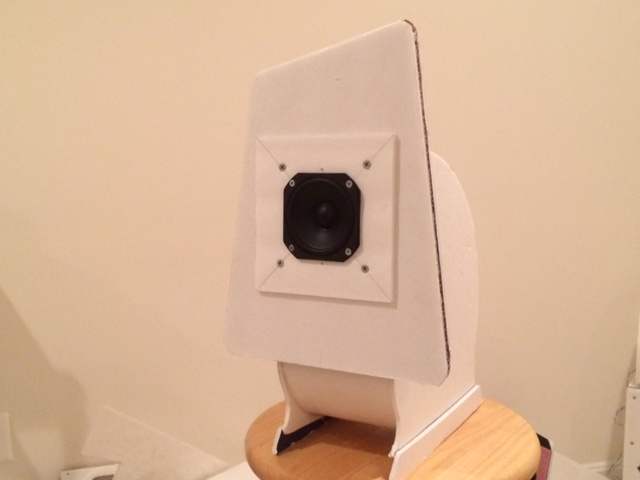
Dimensions of trapezoidal supra-baffle (edge lengths): top=7.0in, bottom=12.0in, left=11.25in, right=13.0in. Driver centerline is 5.0in from left bottom corner and 6.0in up from bottom edge.
Here is the measurement in a trapezoidal supra-baffle mounted on the Nautaloss with a TC9FD. The measurement is near field with mic at 12.7cm away. I think the design seems to provide a very smooth response in the near-field.
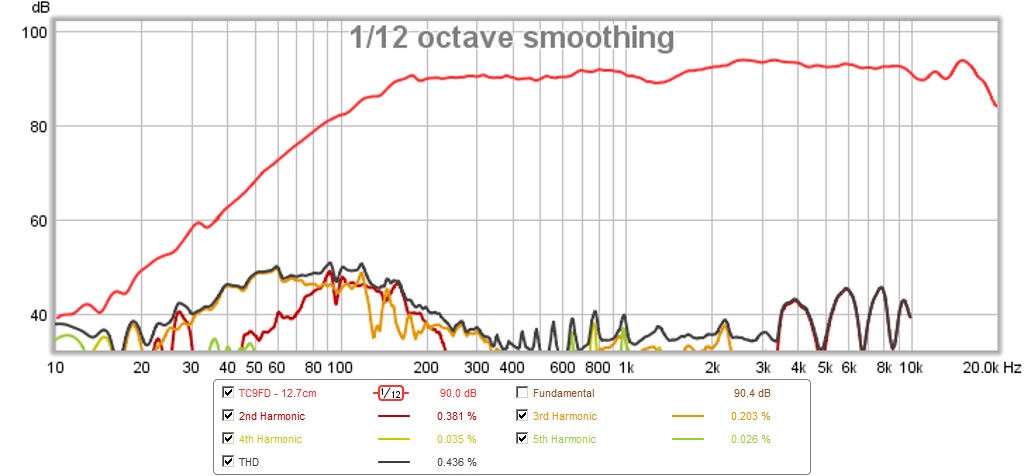
What do you all think of this approach?
Attachments
Last edited:
Response and Harmonic Distortion of Various Competitors
Using the same trapezoidal supra-baffle and Nautaloss rear chamber as the base test setup, I measured the following drivers at the same 12.7cm mic distance: Faital Pro 3FE22 (4 ohm), 3FE22 (16 ohm), Dayton RS100-4 (aluminum cone), RS100P-4 (paper cone).
Here is the lineup of the drivers to be tested:
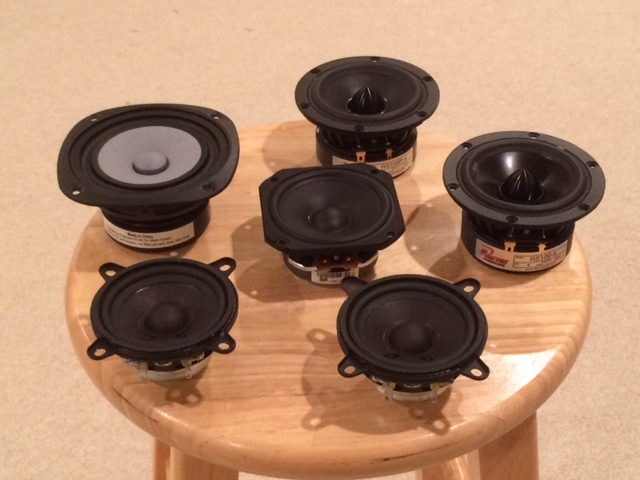
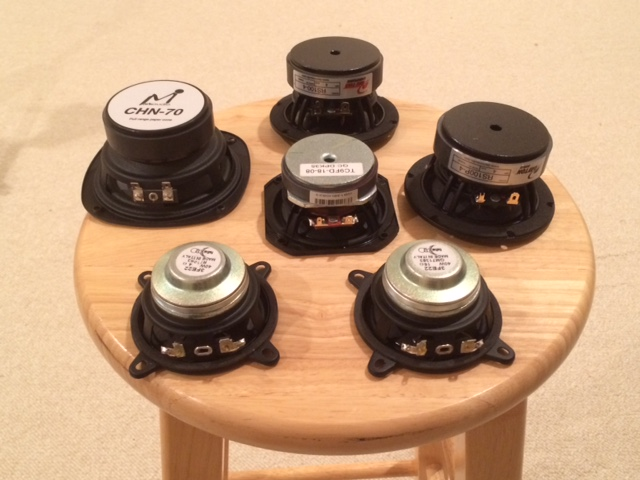
3FE22-4:
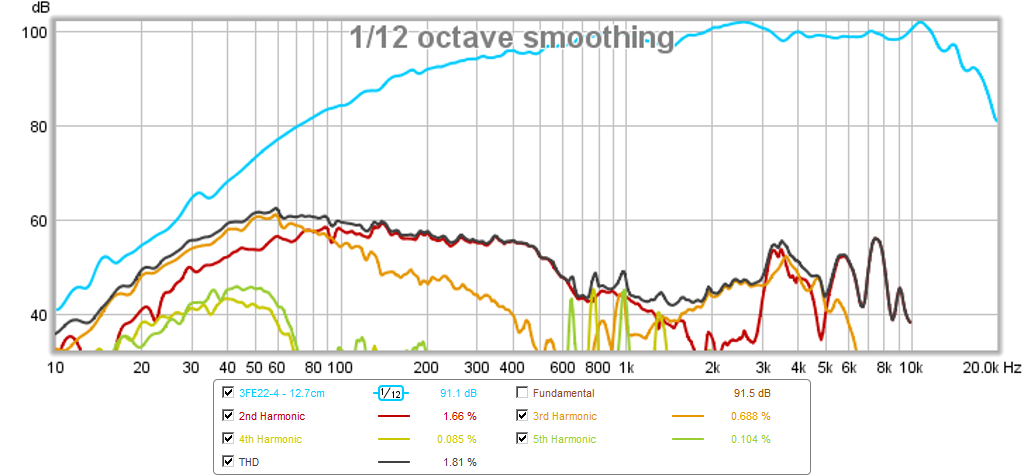
3FE22-4 Compared with TC9FD:
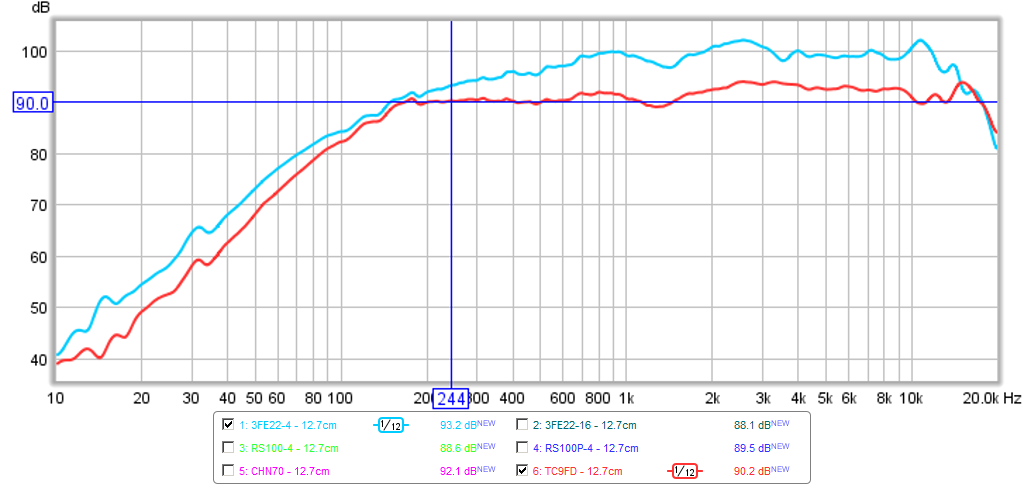
3FE22-16:
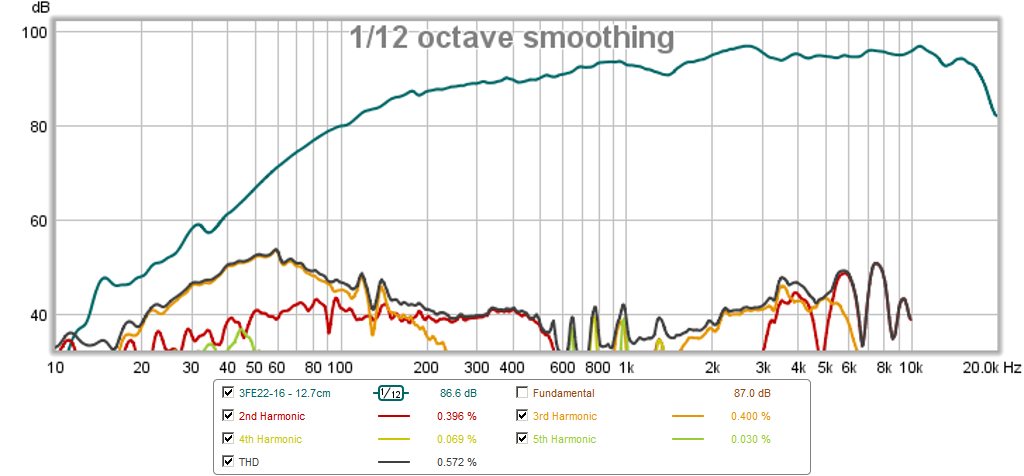
3FE22-16 Compared with TC9FD:
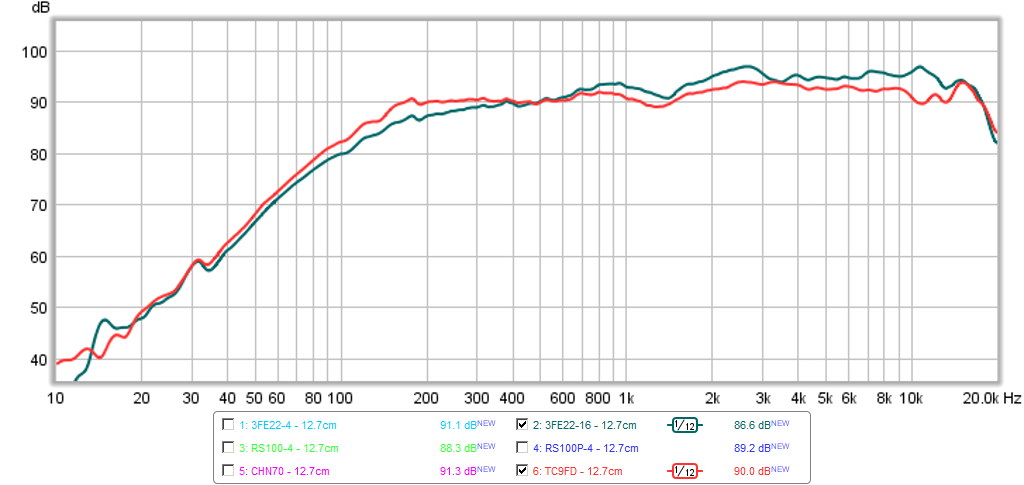
RS100-4:
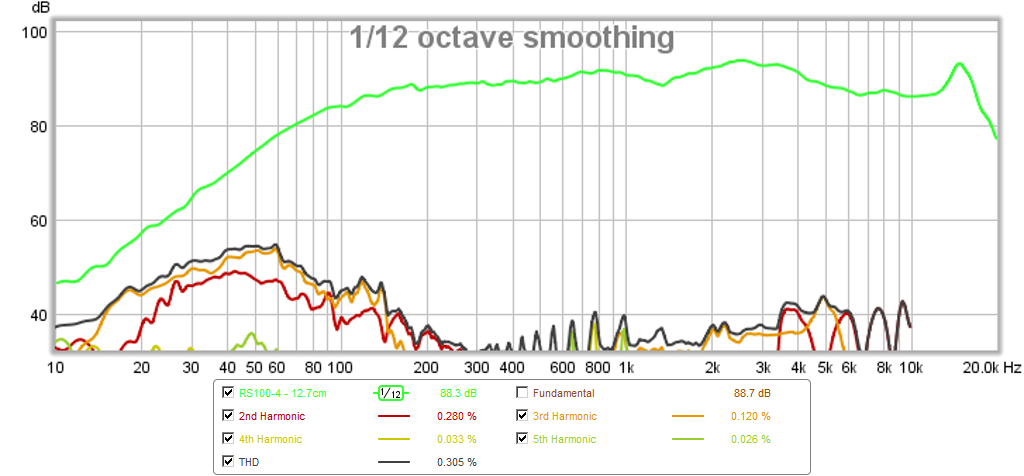
RS100-4 Compared with TC9FD:
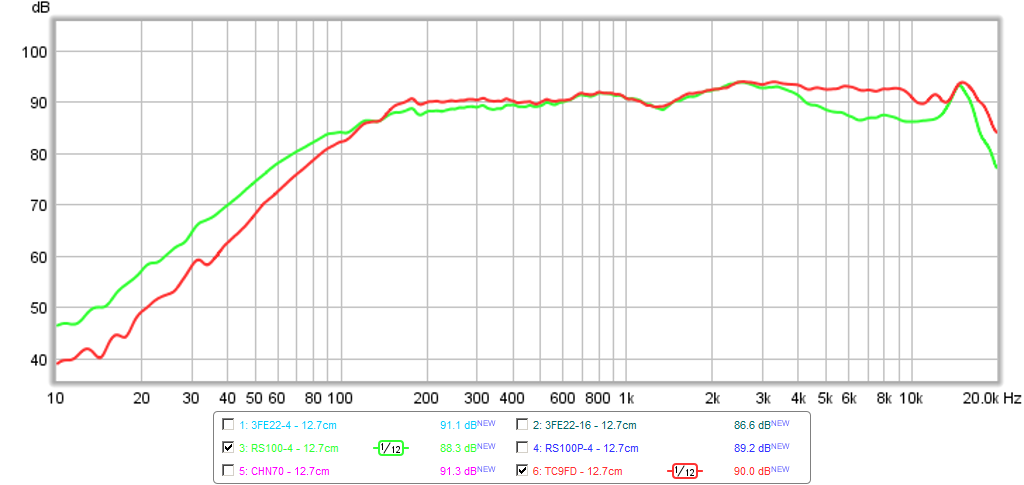
RS100P-4:
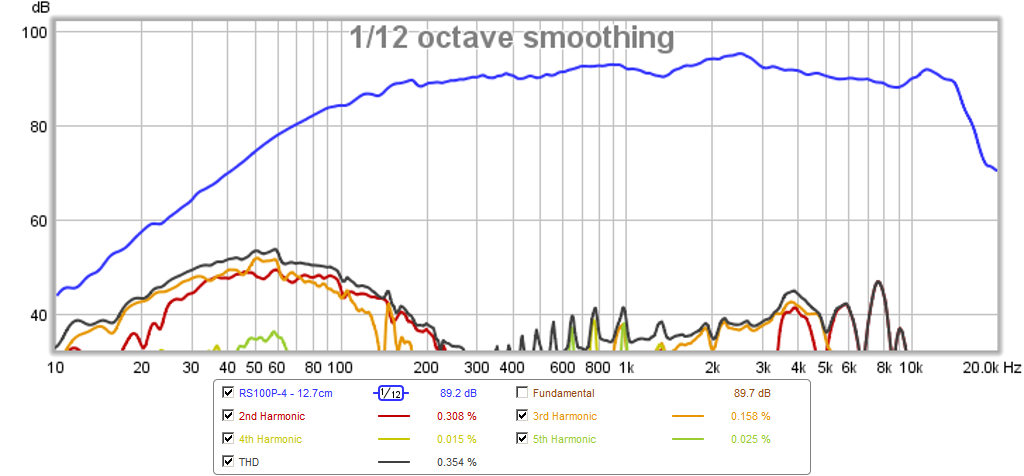
RS100P-4 Compared with TC9FD:
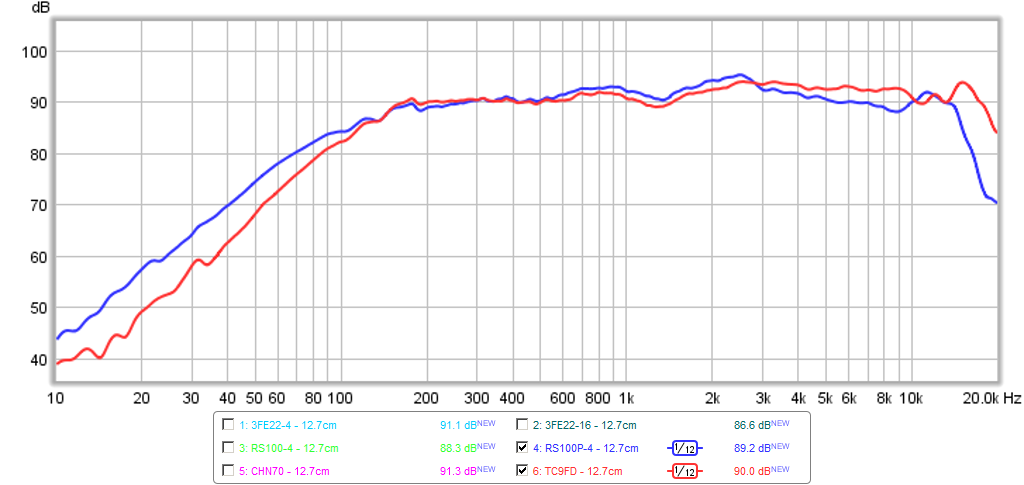
As you can see, the 3FE22-16 is probably the closest to the TC9FD in smoothness and flat response and reach. The 3FE22-4 is about the same but since it is a 4ohm driver, it has more excursion and more SPL so the HD is higher for same drive level. If you turn down drive level, probably about the same response as the 16ohm version (this may be a good option for those with high impedance tube amps). The aluminum cone RS100-4 has a sharp peak near 15kHz that will show up as ringing and sibilance. So far, the TC9FD is really the star here. The shallow depression near 1.4kHz appears to be consistent between drivers and is probably a characteristic of the Nautaloss cabinet.
Using the same trapezoidal supra-baffle and Nautaloss rear chamber as the base test setup, I measured the following drivers at the same 12.7cm mic distance: Faital Pro 3FE22 (4 ohm), 3FE22 (16 ohm), Dayton RS100-4 (aluminum cone), RS100P-4 (paper cone).
Here is the lineup of the drivers to be tested:


3FE22-4:

3FE22-4 Compared with TC9FD:

3FE22-16:

3FE22-16 Compared with TC9FD:

RS100-4:

RS100-4 Compared with TC9FD:

RS100P-4:

RS100P-4 Compared with TC9FD:

As you can see, the 3FE22-16 is probably the closest to the TC9FD in smoothness and flat response and reach. The 3FE22-4 is about the same but since it is a 4ohm driver, it has more excursion and more SPL so the HD is higher for same drive level. If you turn down drive level, probably about the same response as the 16ohm version (this may be a good option for those with high impedance tube amps). The aluminum cone RS100-4 has a sharp peak near 15kHz that will show up as ringing and sibilance. So far, the TC9FD is really the star here. The shallow depression near 1.4kHz appears to be consistent between drivers and is probably a characteristic of the Nautaloss cabinet.
Attachments
-
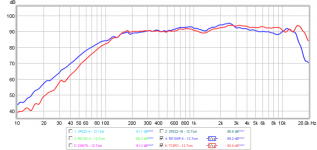 tc9fd-vs-rs100p-12.7cm-freq.png64.4 KB · Views: 7,248
tc9fd-vs-rs100p-12.7cm-freq.png64.4 KB · Views: 7,248 -
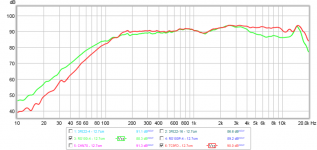 tc9fd-vs-rs100-12.7cm-freq.png65.3 KB · Views: 7,493
tc9fd-vs-rs100-12.7cm-freq.png65.3 KB · Views: 7,493 -
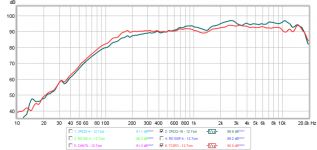 tc9fd-vs-3fe22-16-12.7cm-freq.png67.1 KB · Views: 7,620
tc9fd-vs-3fe22-16-12.7cm-freq.png67.1 KB · Views: 7,620 -
 tc9fd-vs-3fe22-4-12.7cm-freq.png69.5 KB · Views: 7,356
tc9fd-vs-3fe22-4-12.7cm-freq.png69.5 KB · Views: 7,356 -
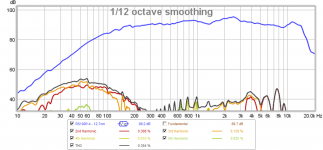 rs100p-4-hd-12.7cm.png97.5 KB · Views: 7,274
rs100p-4-hd-12.7cm.png97.5 KB · Views: 7,274 -
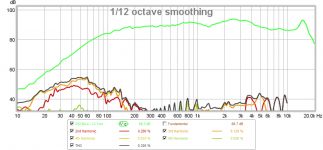 rs100-4-hd-12.7cm.png99.1 KB · Views: 7,304
rs100-4-hd-12.7cm.png99.1 KB · Views: 7,304 -
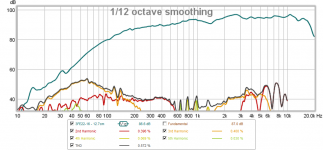 3fe22-16-hd-12.7cm.png106.4 KB · Views: 7,335
3fe22-16-hd-12.7cm.png106.4 KB · Views: 7,335 -
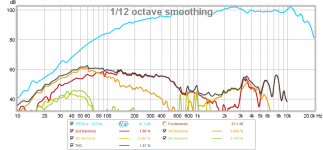 3fe22-4-hd-12.7cm.png122 KB · Views: 7,726
3fe22-4-hd-12.7cm.png122 KB · Views: 7,726 -
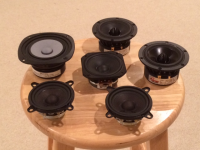 Driver-lineup-top.png405.7 KB · Views: 1,603
Driver-lineup-top.png405.7 KB · Views: 1,603 -
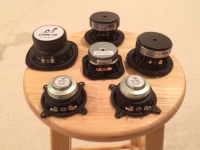 Driver-lineup-bottom.png440.2 KB · Views: 7,748
Driver-lineup-bottom.png440.2 KB · Views: 7,748
Last edited:
- Home
- Loudspeakers
- Full Range
- Vifa TC9FD18-08 best bang for the buck


